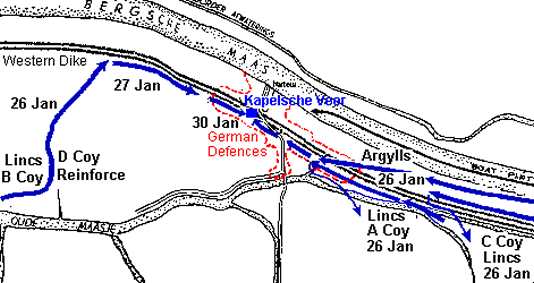The New Brunswick Rangers 4th succesfull attempt day 1
A smoke barrage augmented by the use of smoke generators heralded the start of Operation ELEPHANT at 0715 on 26 Jan 1945. The right hand attack got underway at 0725, with "C" Company supported by four Wasps crossing the bridge, linking up with "A" Company who had crossed by Buffalo amphibious tractor a mile and a half to the east. The Wasps were too heavy to mount the dyke and the infantry had to push on alone.
The objectives were two houses, codenamed by a Canadian staff officer GRAPES and RASPBERRY. The canoe party also set off from the island near the "Dream", though an inch of ice on the river required them to haul the boats out over the ice to the water. Thoroughly wet and cold, the party was forced deep into the stream by the ice, where the smoke cover was less dense and dissipating due to a shift in the wind.
The party came under fire from the north bank as it paddled to the harbour and several canoes were sunk. The survivors disembarked on the island about halfway to the objectives, but the 60 men had dwindled to just 15. German machine guns firing on fixed lines through the smoke met them on the top of the dyke, and attempts to return fire were ineffective owing to weapons frozen solid after their soaking in the canoes.
Lincoln and Welland soldiers in white snowsuits, after the battle at the Veer, Feb 1945. LAC Photo. In the meantime, "A" Company pressed to within 30 yards of GRAPES before being repulsed by heavy fire. The Lifebuoy operators were especially vulnerable and the combination of 60 pounds of dead weight on their backs combined with the use of metal-cleated boots in the snow and ice resulted in all the flamethrower operators being killed. By 0945, "A" Company was stopped cold, and the survivors dug in on the dyke a few hundred yards from the objective. A heavy counter-attack drove them back further into "C" Company coming up behind them. "C" Company lost all its officers, and by 1130 the right-hand attack was all over. The remnants of "A" and "C" Companies were withdrawn from the island. The left hand attack went well initially; "B" Company of the Lincoln and Wellands crossed to the island in Buffaloes and moved along the dyke under good smoke cover towards RASPBERRY until stopped by heavy fire. By noon the left hand attack was also over.
The South Albertas had provided indirect fire from one troop but played no further part in the morning's fighting. Brigadier Jefferson, commander of the 10th Brigade, ordered renewed attacks with the Lincoln and Welland continuing the advance on the left and the Argyll and Sutherland Highlanders of Canada taking over the attack on the right. Tanks of the South Albertas were ordered forward to support both attacks.
While the "Dream" was considered suitable for tanks, getting tanks to support the left hand attack would require rafting them over, and 9 Field Squadron, RCE, was ordered to assemble materials to build a Class 40 raft on the bank of a subsidiary canal.
Two Stuart Tanks of the SAR crossed the "Dream" but found little traction on the dyketop and not enough room to turn around. The Argylls, now on the eastern end of the island, were under mortar fire from across the Maas. The pair of Stuarts spent the next two days providing fire support with their 37mm guns and machine guns, as well as using their armour to safely transport wounded soldiers and bring up ammunition and supplies to forward positions.
At the west end of the island, the engineers found constructing the raft to be a very complicated and time-consuming process, exacerbated by the need to work in the water which was partially frozen. A German patrol and a sudden snow-storm on the night of 26-27 Jan also delayed the construction. Tank support for the Lincoln and Wellands would have to wait.
Listing Details
Date
Status coordinate
No status yet
Address
Veerweg, Capelle, Netherlands
Read more about this record (link)
Source of the information (link)
E-mail publisher
1,248
User
Fred Vogels
Please look at my personal website https://www.fredvogels.com
Map


